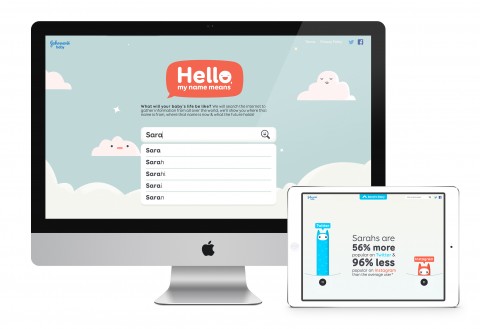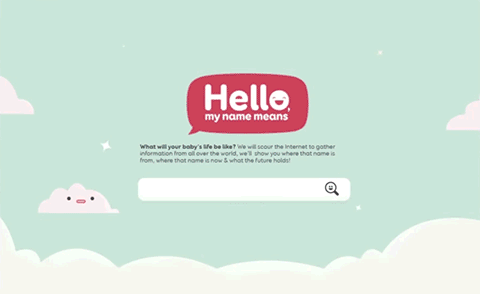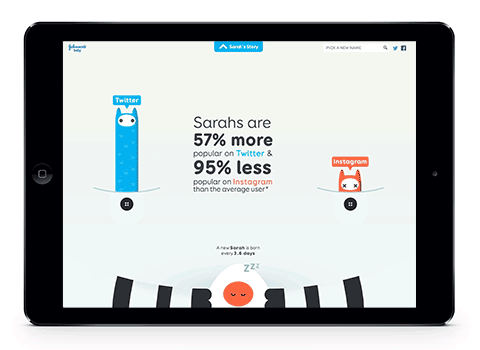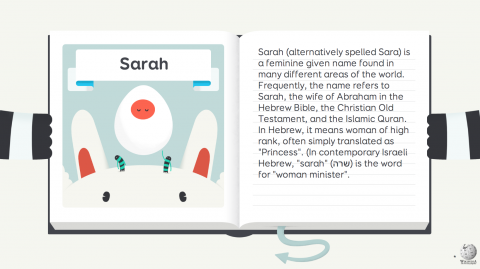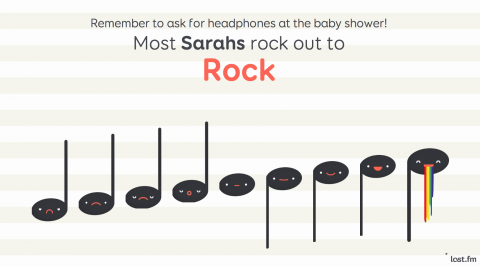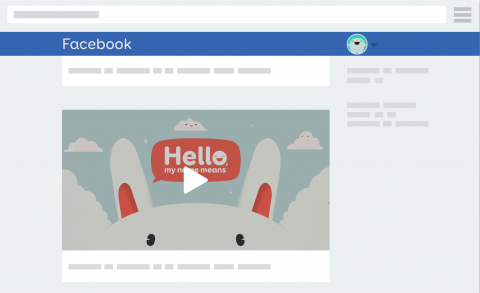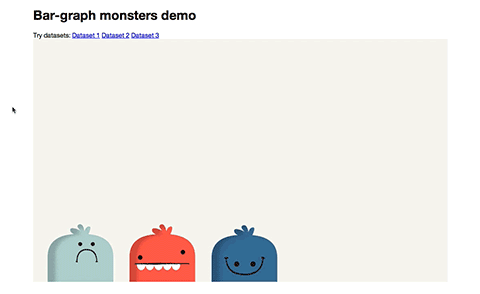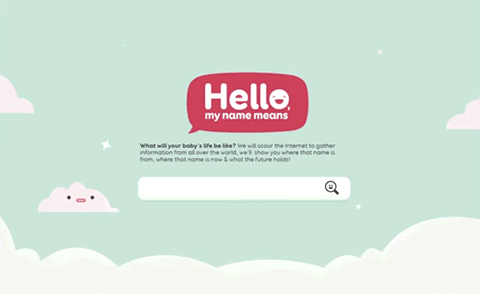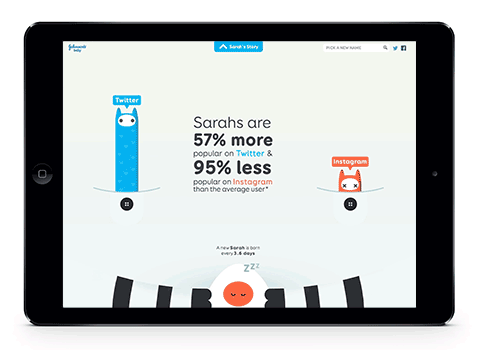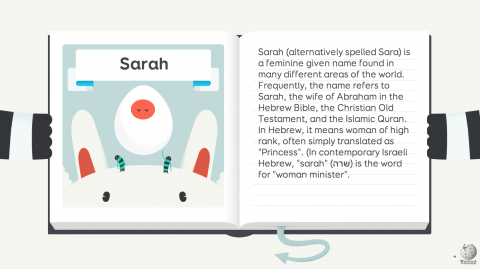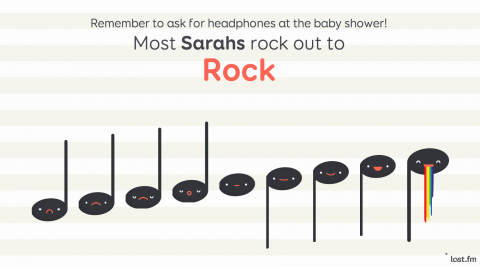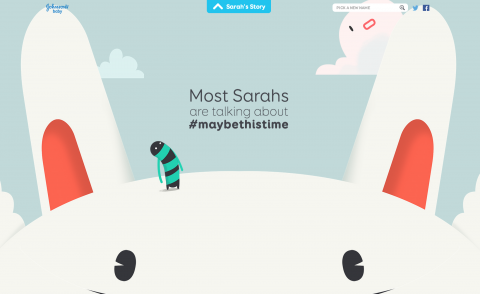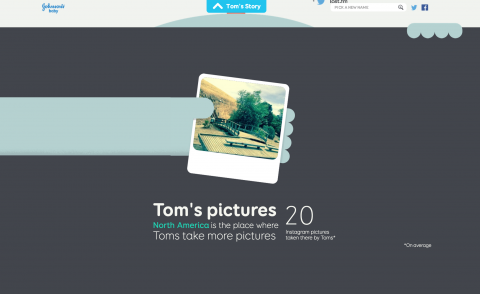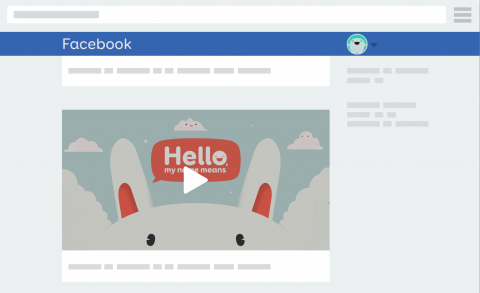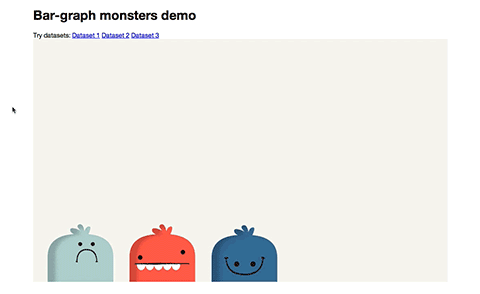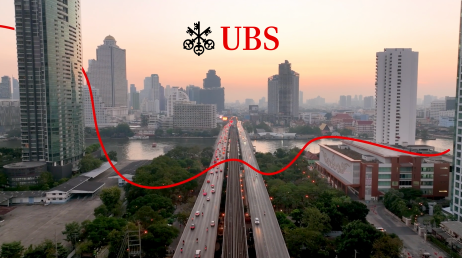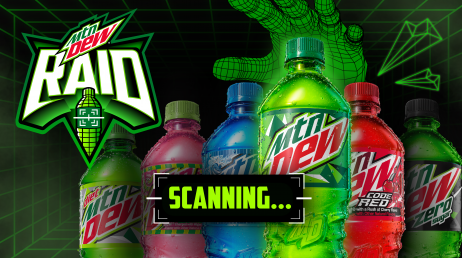What will your baby’s life be like? This unique tool from Johnson’s Baby searches the internet for information about the hidden meanings of names to help parents find the perfect fit.
What is the history of a name? How have people with that name lived in the past, and what would that name mean for your baby’s future? Johnson’s Baby, DM9DBB, and UNIT9 have created a tool that answers those questions. Hello, My Name Means captures real-time data from the world’s top social media sites to predict the future of a baby’s name.
"Hello, My Name Means" is an HTML5 microsite that takes advantage of complex APIs to compile and analyze large data sets from 5 independent sources. We show you where the name has been, where it is now, and where it is going to be.
Every experience generated by "Hello, My Name Means" pulls information from:
•SSA.gov – We search for baby names in the public domain data SSA collected over the last 100+ years in the US. The extensive database—with more than 91 000 unique names—gives us an estimation of how many “Sarahs” and “Toms” are in the world and whether a name was more popular in the ’60s or the ‘80s or even today.
• Wikipedia – Using various filters and flags to remove irrelevant content, we locate a suitable wikipedia article to find information about the origin of the name. We also use Google Translate to generate the variations of the name in English, German, French, Italian, and Portuguese.
• Last.FM – We’ll search the most recent tracks on Last.FM to get an idea of what music the “Sarahs” or “Toms” of the world love. The algorithm will pull and analyze songs inspired by the name, so parents can check whether their baby will grow up to listen to rock, rap, or classical music.
• Twitter & Instagram - Finally—to learn more about modern interests, ambitions and popularity—we go through hundreds of tweets and Instagram posts with particular query filters to get meaningful trends and content.
Even though we’re able to collect such large amounts of data in such a short amount of time, the application is bound to face challenges from third party APIs.
Sam Brown, Tech Lead on Hello, My Name Means, explains how the team made all this possible: “A multi-layered backend cache was key to ensuring data processing times were kept to a minimum while the experience remained highly usable. Not only did this help us stick within third party API rate and throttle limits, it gave us good overall support for redundancy when large volumes of traffic queried tens-of-thousands of names.”
Of course, accessing the data is only the first step. Brown continues: “We were able to make interesting assertions and assumptions about the future of a baby’s name using both simple and arbitrary algorithms, to more complex and systematic ones — analyzing trends in SSA data, looking for tweets containing certain phrases, identifying Instagram shots by the uploader’s username, carefully analysing wikipedia articles for historical context and more. The application is served using Django, the modern Python framework.”
The data is then used to generate a colorful animation that tells the story of the user’s chosen name. Using animations created by the talented UNIT9 illustrators, the developer team used code to customise the experience for each search without compromising the quality of the animations.
To complete the experience, Hello, My Name Means generates an animated video for each search. Parents can automatically share the video and announce what their selection to their friends on any social network.
We wanted the movie to be close to a video, with proper controls. To achieve this in a web context we used a time-lining library (GSAP) that provided us with exactly what we needed. Other modern technologies used include Snap for SVG manipulation and animation, backbone for application management and stellar for some parallax effects. We developed the application using CoffeeScript, SASS, Jade & Python – other tools include Grunt and Bower.
Within hours of launch, Hello, My Name Means received over 83.7k views with an average of 6 minutes spent on sight. Making the Johnson’s Baby brand part of babies’ lives even before they are born.
So, what name will you chose?
What will your baby’s life be like? This unique tool from Johnson’s Baby searches the internet for information about the hidden meanings of names to help parents find the perfect fit.
What is the history of a name? How have people with that name lived in the past, and what would that name mean for your baby’s future? Johnson’s Baby, DM9DBB, and UNIT9 have created a tool that answers those questions. Hello, My Name Means captures real-time data from the world’s top social media sites to predict the future of a baby’s name.
“Hello, My Name Means” is an HTML5 microsite that takes advantage of complex APIs to compile and analyze large data sets from 5 independent sources. We show you where the name has been, where it is now, and where it is going to be.
Every experience generated by “Hello, My Name Means” pulls information from:
SSA.gov – We search for baby names in the public domain data SSA collected over the last 100+ years in the US. The extensive database—with more than 91 000 unique names—gives us an estimation of how many “Sarahs” and “Toms” are in the world and whether a name was more popular in the ’60s or the ‘80s or even today.
Wikipedia – Using various filters and flags to remove irrelevant content, we locate a suitable wikipedia article to find information about the origin of the name. We also use Google Translate to generate the variations of the name in English, German, French, Italian, and Portuguese.
Last.FM – We’ll search the most recent tracks on Last.FM to get an idea of what music the “Sarahs” or “Toms” of the world love. The algorithm will pull and analyze songs inspired by the name, so parents can check whether their baby will grow up to listen to rock, rap, or classical music.
Twitter & Instagram – Finally—to learn more about modern interests, ambitions and popularity—we go through hundreds of tweets and Instagram posts with particular query filters to get meaningful trends and content.
Even though we’re able to collect such large amounts of data in such a short amount of time, the application is bound to face challenges from third party APIs.
Sam Brown, Tech Lead on Hello, My Name Means, explains how the team made all this possible: “A multi-layered backend cache was key to ensuring data processing times were kept to a minimum while the experience remained highly usable. Not only did this help us stick within third party API rate and throttle limits, it gave us good overall support for redundancy when large volumes of traffic queried tens-of-thousands of names. Any data the application isn’t able to get first time round, will be downloaded the next time, and cached for future users.”
Of course, accessing the data is only the first step. Brown continues: “Working within the limits of the 3rd party APIs, we were able to make interesting assertions and assumptions about the future of a baby’s name using both simple and arbitrary algorithms, to more complex and systematic ones — analyzing trends in SSA data, looking for tweets containing certain phrases, identifying instagram shots by the uploader’s username, carefully analysing wikipedia articles for historical context and more. The application is served using Django, the modern Python framework.”
The data is then used to generate a colorful animation that tells the story of the user’s chosen name. Using animations created by the talented UNIT9 illustrators, the developer team used code to customise the experience for each search without compromising the quality of the animations.
To complete the experience, Hello, My Name Means generates an animated video for each search. Parents can automatically share the video and announce what their selection to their friends on any social network.
We wanted the movie to be close to a video, with proper controls. To achieve this in a web context we used a time-lining library (GSAP) that provided us with exactly what we needed. Other modern technologies used include Snap for SVG manipulation and animation, backbone for application management and stellar for some parallax effects. We developed the application using CoffeeScript, SASS, Jade & Python – other tools include Grunt and Bower.
Within hours of launch, Hello, My Name Means received over 83.7k views with an average of 6 minutes spent on sight. Making the Johnson’s Baby brand part of babies’ lives even before they are born.
So, what name will you chose?
Credits
-
Division
-
Director
-
Agency
-
Brand
-
Concept
-
Creative Director
-
Creative Director
-
Creative Director
-
Producer
-
Tech Lead
-
Front End Developer
-
Back End Developer
-
UX
-
Storyboard and Animations
-
Storyboard and Animations
-
Copywriter
-
Editor
-
SFX
-
Technology
-
Platform
-
Kind
-
Industry
-
Target Market
-
Release Date
2014-06-11

